Solution to Finding a Duck Hiding Amongst Other Animals
The Wood Ducks of Effie Yeaw
January 23, 2016
Written by Thom Parrish
The wood duck is another iconic North American animal that we are fortunate to find in the Effie Yeaw nature preserve. The beauty of the wood duck has inspired stories in the oral traditions of Native Peoples as well has being a common theme found in American folk art. Hand painted wood duck decoys are a popular item among collectors. My mother collected pieces of American folk art that she used to decorate our home when I growing up in Illinois. Most of her collection consisted of old antique dolls that made walking around the house at night terrifying for a kid, but among the items she used to decorate the house was a hand painted wood duck.
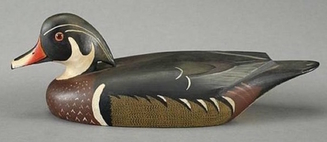
I liked to play with that wood duck, I remember lying on the floor and scooting it along the carpet like the surface of a pond. It has always been exciting for me to see a wood duck. Because of their shy behavior and striking appearance, sightings feel like spotting a rare and magical creature.
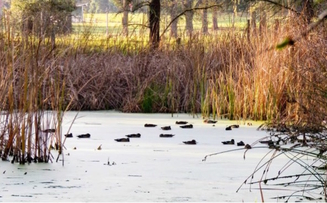
I see wood ducks on occasion swimming in the nature study pond at Effie Yeaw. Usually I see only one or two ducks and the sighting is brief. Earlier this month on the 16th, I was walking the meadow view trail in the preserve and decided to stop by the pond. It was early in the morning and I was hoping to see some wildlife. When I arrived at the pond I was astonished to see the shapes of over a dozen wood ducks gathered together on the far side. I quietly sat down to watch them and I began to count; 22 wood ducks! I have never seen so many at one time.
Later as I was bragging to everyone in the Nature Center about hitting the wood duck jack-pot, Effie Yeaw naturalist, Rachel Cowan, told me that on the 29th of December she had counted 31 wood ducks in the nature study pond!
-----------
The wood duck, Aix sponsa, aka the Carolina duck, swamp duck, and the acorn duck. The name �swamp duck� sounds more fitting for a slimy green duck monster (which is fun to imagine) but no, this duck is far from being an ugly duckling. This lucky-duck is one of the most colorful and stunningly beautiful of all North American waterfowl.
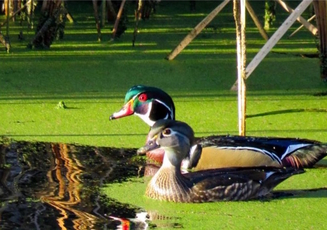
I wanted to get a clean close up photo of the wood ducks for this entry; the photo above is I think the closest I�ve come so far. Taking photos of the wood ducks at Effie Yeaw is not easy! First of all, wood ducks are notoriously difficult to photograph. That�s right, I�m blaming the ducks! Wood ducks are an extremely shy and skittish species of duck. The slightest movement or sound from a perceived threat will cause them to take flight or send them scurrying for the protective cover of vegetation. I have tried many times without success to sneak up for that clean close-up. Every time the wood ducks sense my interest and scurry to cover before I can take the picture. The mallards, not so easily scared, are much more cooperative when it comes to posing for photo shoots.
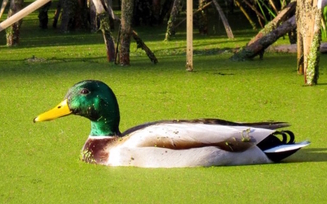
To get some better shots of the wood ducks I think I might have to up my game to the next level like this guy, haha.
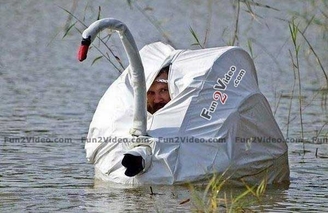
Interestingly however, there are places where wood ducks do not behave so shy. There are wood ducks living in the duck pond at McKinley Park on the corner of Alhambra and H St in Sacramento. There the wood ducks swim around care-free and even will come up to people. These city wood ducks apparently do not see humans as a threat; maybe this is because their diet consists largely on human hand outs. Perhaps there are also fewer natural predators found around city park ponds as well.
My second excuse for why photographing the Effie Yeaw wood ducks is difficult is the same reason why the nature study pond is a perfect wood duck habitat! Wood ducks thrive best in wooded swamps, marshes and ponds that offer 50%-70% vegetative cover to hide and forage in. The nature study pond at Effie Yeaw is nearly entirely enclosed in a fortress of cattail, tule, sedge grass and willow, offering the wood ducks optimal protection. The front end of the pond along the trail has been cleared of cattails to provide a viewing area into the pond, but there is still plenty of cover for the wood ducks to feel safe while foraging.
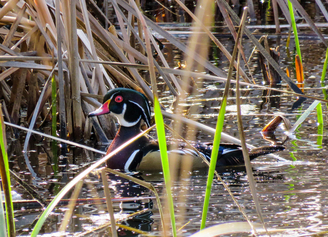
So why have so many wood ducks been gathering at the nature study pond? Early winter is when wood ducks gather to find mates. During the month of January it is not uncommon to see flocks of 20 or more wood ducks gathered together in one place.
As the ducks gather on the breeding grounds the mate choice is decided by the female hen. Wood ducks do not form life long mated pairs, but rather practice what is known as �seasonal monogamy.� A mated pair will stay together during the breeding season, after which they will part ways. During the time they are together the male �drake� will stay with the hen to protect the territory and the nest. Drake�s will typically leave their mates mid-way through the egg incubation period to go off on their own, sometimes finding new mates during the same season. Wood ducks are the only North American duck known to sometimes produce two broods in a year. After pairs are formed the wood ducks will leave to find nesting sites of their own. Only one or two pairs may remain at the breeding grounds to nest depending on available nesting sites.
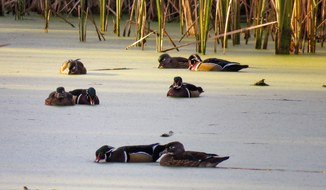
Wood ducks are so named �wood ducks,� because unlike many species of duck that nest on the ground, wood ducks nest high above in the empty cavities of trees! Also unlike other ducks, wood ducks have sharp claws on their webbed feet! These claws help them climb up tree bark and even grip branches to perch. The Hens will choose a suitable nest site, ideally in a tree within close proximity to water. The hen will line the nest with down and wood chips and typically lay between 10 and 15 eggs. If there are insufficient nesting sites, a hen will sometimes lay her eggs in another hen�s nest. Then that hen will raise the combined mixed brood. Sometimes hens will also lay eggs in a �dump nest� where no incubation at all takes place. Some dump nests may contain over 50 eggs, left never to hatch. Incubation is done by the hen only and lasts about one month.

The morning after the ducklings hatch the mother hen will leave the nest, go to water and call her ducklings to join her for their first swim lesson. What happens next is truly one of the most amazing animal behaviors found in nature. These little ducklings that have hatched just one day prior will use their little clawed webbed feet to climb up to the nest cavity opening. High above the ground the ducklings have their first view of the outside world from the lip of a cavity opening upwards of 65 feet above the ground. Anxious to rejoin their mother, the ducklings will take an amazing leap of faith towards her call. One by one the ducklings leap from the nest to fall sometimes five stories down to the ground. They are so light that they often land with a cute little bounce, unharmed.
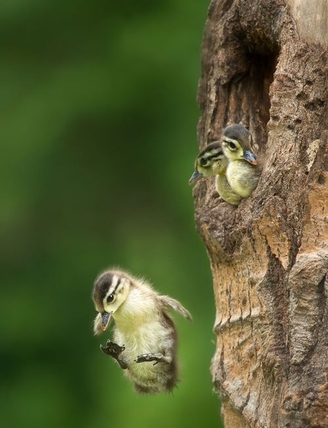
The young ducklings will be cared for by the mother hen for 5-6 weeks, during which time she will teach them everything they need to know to survive and forage on their own. The ducklings will be capable of flight 8 weeks after hatching.
Approximately 80% of a wood duck�s diet consists of vegetation; mostly seeds and aquatic plants such as duck weed. Acorns are also a major part of the diet of wood ducks in areas where oak trees are prominent, which is why they are sometimes referred to as �acorn ducks�. The rest of their diet consists of insects and aquatic arthropods.
Wood ducks have a high mortality rate as a result of animal predation. This is the reason for why the wood duck is so shy. They are smaller in size than many of the other resident duck species and also lack the powerful pectoral flight muscles that ducks like mallards have, making the weaker wood duck an easier prey item. Wood ducks also nest in close proximity to many of their would-be predators. Predators of the wood duck include otters, raccoons, opossums, aquatic reptiles, and raptor birds. The average life span of a wood duck in the wild is approximately 4 years, in captivity they have been known to live into their teens.
The wood duck is sometimes also referred to as the �Carolina duck�, due to the fact that North Carolina is where they were first scientifically described. The wood duck however, can be found throughout most of the United States as well as some southern parts of Canada and Northern Mexico. Wood ducks can be found year-round in the marshy areas of the American Parkway. The wood duck is endemic to North America, although their closest relative is the Mandarin duck of East Asia. The Mandarin duck is the only other duck that shares the same genus, Aix.
During the early part of the 20th century the wood duck faced near extinction due to major deforestation of large nesting trees and unregulated hunting. To address the loss of natural nesting trees, county and state agencies will often install artificial nest boxes in appropriate habitats for wood duck use. At Effie Yeaw, two wood duck boxes have been placed near the nature study pond to facilitate the survival of the wood ducks that come there to nest. Wood ducks are currently listed as a species of least concern.

With the warm temperatures we�ve been experiencing this week it feels like spring is arriving early. Already hibernating animals are starting to wake from their winter nap. In the evening you can already hear the quacks of chorus frogs singing. (That�s right, I said, �quacks,� I don�t think I�ve ever heard a frog say �ribbit!� You know who doesn�t quack? Wood ducks! Drake�s make a kazoo like �jeeee,� sound and the hens have a low soft owl like, �whoo-w-eet�)
.
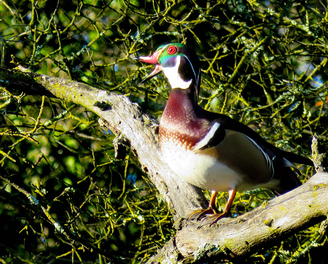
The frogs are not the only animals coming out of hibernation at the nature study pond, just yesterday I spotted this guy swimming around, a western pond turtle!
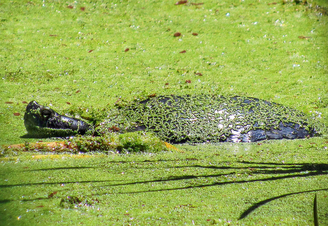
Western pond turtles are among the would-be predators of wood ducklings, but it is still exciting to see one in the pond. The nature study pond is one of my favorite places in the preserve to sit and quietly wait for wildlife to do something cool. I�m looking forward to seeing a train of little wood ducklings following their mother there in the spring.

Solution to Finding a Duck Hiding Amongst Other Animals
Source: https://www.sacnaturecenter.net/visit-us/nature-blog/news.html?NewsID=44197

0 Response to "Solution to Finding a Duck Hiding Amongst Other Animals"
Post a Comment